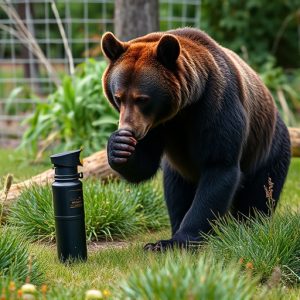Maximizing Bear Spray Effectiveness: Storage, Use, and Legal Insights
Bear spray, an effective deterrent against aggressive bears, contains capsaicin from chili peppers……..
Bear spray, an effective deterrent against aggressive bears, contains capsaicin from chili peppers. It creates an offensive cloud when used correctly at a distance of 20-30 feet. To maintain maximum effectiveness, store bear spray between 50-70°F (10-21°C) away from direct sunlight and moisture. Extreme temperatures can solidify or evaporate the chemical, impacting its shelf life. Proper storage and application techniques are crucial for reliable defense against bears, with legal considerations also important in many regions.
Bear spray, a potent defense weapon against aggressive bears, offers a non-lethal solution for outdoor enthusiasts. This article delves into the science behind bear spray, exploring its composition and effectiveness. We uncover optimal storage conditions, including the critical proper temperature for bear spray storage, to maintain maximum strength. Additionally, we discuss factors influencing performance and provide application techniques for optimal defense. Legal considerations and responsible ownership practices are also addressed.
- Understanding Bear Spray: Its Composition and Effectiveness
- Optimal Storage Conditions for Maximum Strength Bear Spray
- Factors Affecting Bear Spray Performance
- Application Techniques for Effective Defense
- Legal Considerations and Responsible Ownership
Understanding Bear Spray: Its Composition and Effectiveness
Bear spray, also known as bear repellent, is a powerful defensive tool designed to deter and repel aggressive bears when used correctly. Its primary active ingredient is a pepper-based compound, often capsaicin, which is derived from chili peppers. This substance irritates a bear’s eyes, nose, and respiratory system, causing them to flee the area for fresh air. The composition also includes other components like water, propellants, and thickening agents to ensure effective distribution.
The effectiveness of bear spray lies in its ability to create a large enough barrier between you and the bear to give you time to escape or defend yourself. When used at the recommended distance, typically 20-30 feet (6-9 meters), it creates an offensive cloud that can reach up to 40 feet (12 meters) wide. However, understanding the proper storage conditions is crucial for maximum effectiveness. Bear spray should be stored in a cool, dry place, with temperatures ideally between 50-70°F (10-21°C), and out of direct sunlight to maintain its potency. Proper temperature control ensures the spray remains potent when needed, providing vital protection against bear encounters in various outdoor settings.
Optimal Storage Conditions for Maximum Strength Bear Spray
To maintain maximum strength and effectiveness, bear spray should be stored under specific conditions. The most crucial factor is temperature; it’s best to keep your bear spray below 75°F (24°C). Higher temperatures can degrade the active ingredients over time, reducing the spray’s potency. Extreme cold is also detrimental, as it can cause the spray to freeze and become unusable. Ideally, a cool, dry place like an indoor closet or garage is perfect for storage. Avoid leaving it in direct sunlight or near heat sources like radiators or ovens.
Additionally, bear spray should be stored upright and out of reach to prevent any damage to the canister. Keep it away from moisture to avoid corrosion. With proper temperature control and careful handling, your bear spray will remain a reliable defense mechanism when facing potential bear encounters in the wild.
Factors Affecting Bear Spray Performance
The performance of bear spray is influenced by several factors that contribute to its effectiveness as a defense mechanism. One crucial aspect is the proper temperature for storage. Bear spray, like any chemical substance, has an optimal range within which it retains its maximum potency. Extreme temperatures can cause the spray to either solidify or evaporate, reducing its readiness for use in an emergency. Ensuring the spray remains in a cool and dry place, typically between 50°F to 80°F (10°C to 27°C), is essential to maintain its potency.
Additionally, factors such as exposure to direct sunlight or high humidity can impact the spray’s shelf life and performance. Proper storage conditions are vital to guarantee that bear spray remains a reliable defense tool when needed most. Users should be mindful of these variables to ensure their bear spray is ready and effective when encountering a potentially aggressive bear.
Application Techniques for Effective Defense
When using bear spray as a defense weapon, proper application techniques are crucial to ensure its effectiveness. Aiming for the face and eyes is key; bears have sensitive facial areas that can be temporarily blinded or irritated by the spray, giving you valuable time to escape. It’s important to remember to use long, slow breaths while spraying to distribute the aerosol evenly across a wide area. This method allows for maximum coverage on the bear’s mucous membranes.
Storing bear spray at the proper temperature is another essential aspect of maintaining its maximum strength and performance. Most bear sprays recommend storage between 50°F (10°C) and 70°F (21°C). Extreme temperatures can reduce the spray’s effectiveness, so it’s best to keep it in a cool, dry place, away from direct sunlight or frosty conditions. Proper storage ensures that when you need it most, your bear spray will be ready for action.
Legal Considerations and Responsible Ownership
In many regions, bear spray is a legally recognized defense weapon against aggressive bears. However, owning and carrying bear spray comes with significant legal considerations. It’s crucial to understand local laws and regulations regarding the purchase, possession, and use of bear spray. Permits or licenses may be required, and there are often restrictions on where and how it can be carried. Additionally, knowing the proper temperature for bear spray storage is essential; extreme heat or cold can degrade the effectiveness of the spray.
Responsible ownership involves adhering to safety guidelines and best practices. This includes keeping bear spray readily accessible during outdoor activities in bear country, ensuring it’s not frozen or left in a hot vehicle, and understanding how to deploy the spray correctly when facing an attack. Bear spray should only be used as a last resort, and proper training can help individuals make informed decisions in high-pressure situations.
Bear spray, a powerful defense tool, requires proper storage conditions, understanding of its composition, and effective application techniques to ensure maximum strength and reliability. Maintaining the recommended proper temperature for bear spray storage is crucial, as it directly impacts potency. Awareness of factors affecting performance allows users to make informed decisions in unpredictable situations. Responsible ownership, including legal considerations, underscores the importance of education and adherence to guidelines for this valuable self-defense resource when encountering bears in their natural habitats.


